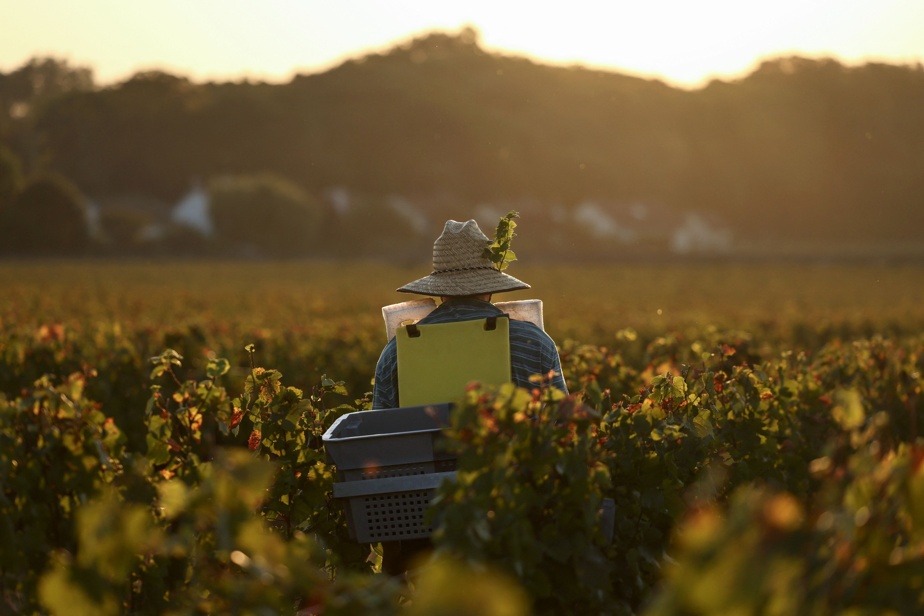(Vougeot) In Clos de Vougeot, a prestigious appellation of French Burgundy wines, the harvesters handle the black-blue bunches of Pinot with infinite care: a bottle here sells for several hundred euros. To the point of alarming wine growers who are hoping for a generous year to calm the inflationary fever.
In Bordeaux, vines are being uprooted due to overproduction; in Burgundy, people are fighting for wine, they joke between the rows of vines on the Côte d’Or.
“The number one problem in Burgundy is the lack of wine,” summarizes François Labet, president of the Interprofessional Burgundy Wine Bureau (BIVB), as the sounds of pruning shears echo across the sun-drenched hillsides.
“To replenish stocks, we hope that these harvests will be abundant, perhaps even beyond 2018”, a record year in Burgundy, adds the operator of Château de la Tour, with the century-old vines planted in Clos de Vougeot.
In July 2022, less than a million hectoliters were offered in the Burgundy estates, i.e. only 14 months of sales, compared to at least two years previously.
The reason for this is the repetition of meager harvests, particularly in 2021: a late frost that year caused the loss of the equivalent of 70 million bottles.
The very abundant 2022 vintage “made it possible to increase stocks by three months, but we would need to gain another two to three months. An abundant 2023 harvest would be enough,” explains Albéric Bichot, president of Maison Albert Bichot, one of the largest traders and producers in Burgundy.
Because consumer appetite continues to grow. So the prices too.
“The surge is very obvious,” summarizes for AFP Angélique de Lencquesaing, co-founder of iDealwine, leader in online wine auctions. From 2017 to 2022, the average price of Burgundies on iDealwine jumped by 145% (from 157 to 384 euros). It was a Burgundy that fetched the most, at 34,100 euros (a Musigny 2006 from Domaine Leroy). A year earlier, the same wine was also the most expensive, but at “only” 28,244 euros.
“Even expensive, it’s gone”
However, the surge does not only concern speculative wines, but also normally affordable wines, says Mme from Lencquesaing.
Thus, in 2022, the average price of a Burgundy rose one euro compared to 2021, to 9.46 euros, according to the BIVB.
“Before, it increased by 5-10%. These last two, three years, it’s been “20, 30 or even sometimes 40%”, laments Andrea Minardi, sales manager at the Marché aux vins, a large wine merchant in Beaune.
The reason is simple, according to him: “it’s a rare product”.
Burgundy produces only 214 million bottles, three times less than Bordeaux. Only a few hundred bottles of Leroy Musigny are released each year, priced at over 33,000 euros.
But, “even expensive, it goes away,” marvels Andrea Minardi.
Particularly abroad: in 2022, exports brought in 1.5 billion euros (+12.9%), according to the BIVB. A record, but in value only: the volume sold fell by 12.3%. Translation: it is the prices that have increased.
“Inflation is becoming delirious,” judges Romain Iltis, wine director for the restaurants of the Swiss luxury group Lalique and author in the Revue du vin de France of an article entitled “We can no longer keep up!” “.
“Burgundy menus are decreasing in restaurants,” he says, fearing the same fate as Bordeaux: “20 years ago, people said “Bordeaux is too expensive” and turned away. Now we are tearing up vines.”
After “Bordeaux-bashing”, “Burgundy-bashing”? “Yes, it can happen to us,” concedes Albéric Bichot. “In the last twelve months, Burgundy has lost 20% of its sales volumes: due to a lack of wine, but also because of the price. Let’s be vigilant,” he warns.
